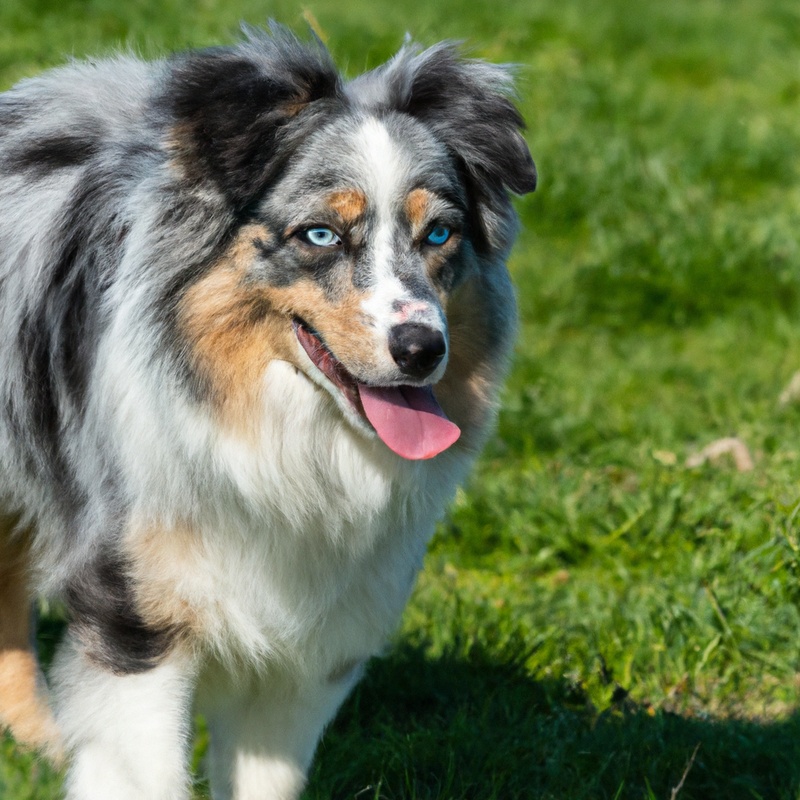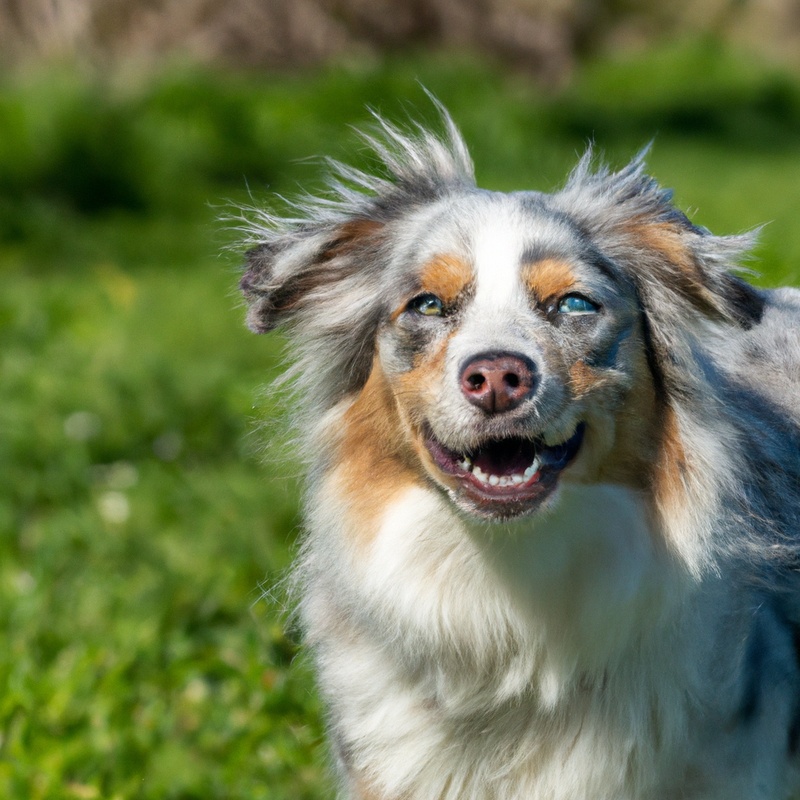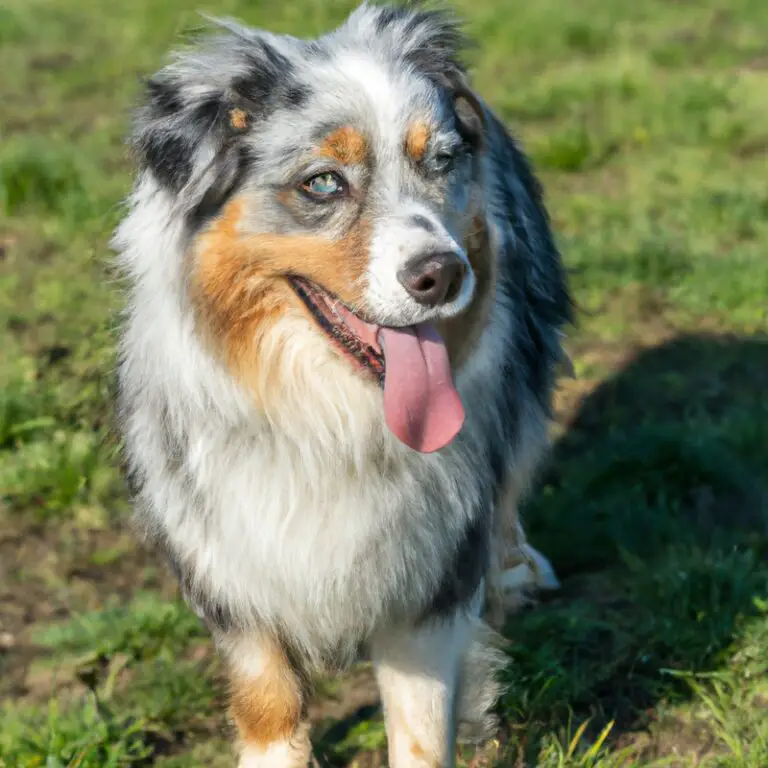Are Australian Shepherds Good With Other Pets?
Key Takeaways:
- Australian Shepherds can be good with other pets if properly socialized from a young age.
- Early introduction and positive experiences with other animals can help Australian Shepherds get along well with other pets.
- Proper training and supervision are essential to ensure a harmonious relationship between Australian Shepherds and other pets.
- While individual temperament may vary, Australian Shepherds generally have a tendency to display herding instincts, which can be managed with proper guidance and training.
Are Australian Shepherds good with other pets? If you’re considering adding an Australian Shepherd to your household, you might be wondering how they’ll get along with your other furry or feathered friends.
As an expert in all things Australian Shepherds, I’m here to shed some light on the topic.
These energetic and intelligent dogs have a reputation for being great companions, but their compatibility with other pets can vary. In this article, we’ll explore the temperament of Australian Shepherds, factors that influence their compatibility, and provide tips for a successful introduction and integration.
So, let’s dive in and find out if Australian Shepherds make good partners in pet-owning bliss!
| Yes | No | |
| Good with cats | ✅ | |
| Good with dogs | ✅ | |
| Good with small animals | ✅ |
Australian Shepherds as a Breed
Brief Overview of Australian Shepherds
Australian Shepherds are medium-sized, athletic dogs with a friendly and intelligent nature. They were originally bred as working dogs on ranches to herd livestock, but have become popular as family pets due to their loyalty and versatility.
They have a distinctive double coat that requires regular grooming to keep it healthy and prevent matting.
Australian Shepherds are known for their high energy levels and need plenty of exercise and mental stimulation to prevent boredom. They are generally good with children and make great companions for active individuals or families who can provide them with the attention and exercise they need.
Additionally, Australian Shepherds are highly trainable and excel in various dog sports and activities.
Overall, they are a loving and versatile breed that can adapt to various lifestyles with proper care and training.
Temperament and Characteristics of Australian Shepherds
Australian Shepherds have a friendly and intelligent temperament. They are known for their loyalty and are great companions.
These dogs have a high energy level and require regular exercise to keep them happy.
One of the key characteristics of Australian Shepherds is their herding instinct. They are natural herders and may try to herd other animals or even children.
This behavior can be managed with proper training and socialization.
Australian Shepherds are generally good with other pets if they are introduced and socialized properly from a young age. They can get along well with other dogs, but early and positive introductions are important.
When it comes to cats, Australian Shepherds can coexist peacefully, although some may have a strong prey drive and may chase small animals.
Supervision and gradual introductions are necessary to ensure a smooth interaction. As for small animals like rodents or birds, Australian Shepherds, due to their herding instincts, may see them as prey and may not be compatible.
It’s best to avoid keeping them together.
Overall, the temperament and characteristics of Australian Shepherds make them adaptable and friendly pets. However, proper socialization, training, and supervision are essential in ensuring a successful integration with other pets.
Compatibility with Other Pets
Australian Shepherds and Dogs
Australian Shepherds can generally get along well with other dogs. They are known for their friendly and sociable nature.
Proper socialization from a young age is important to ensure positive interactions with other dogs.
By introducing Australian Shepherds to different dogs and situations early on, they can develop good social skills. However, it’s important to supervise their interactions initially and ensure that both dogs are comfortable and compatible.
Additionally, each dog is an individual, and personality differences can affect how well they get along.
Providing proper training and establishing clear boundaries can also help to foster positive relationships between Australian Shepherds and other dogs.
Australian Shepherds and Cats
Australian Shepherds can generally get along well with cats, but it depends on the individual dog and cat’s personalities and early socialization. It’s important to introduce them slowly and provide supervision during interactions.
Some Australian Shepherds may have a strong prey drive and may try to chase cats, so it’s crucial to keep that in mind.
Proper training and positive reinforcement can help establish a positive relationship between your Australian Shepherd and your cat. Always prioritize the safety and comfort of all pets involved.

Australian Shepherds and Small Animals (Rodents, Birds, etc.)
Australian Shepherds may have a strong prey drive, which can make it challenging to keep them with small animals like rodents and birds. Due to their herding instincts, they may see these small animals as potential prey and try to chase or nip at them.
It’s crucial to closely supervise their interactions and provide proper training and socialization from an early age.
However, it’s important to note that the compatibility between Australian Shepherds and small animals can vary depending on the individual dog’s temperament and training. It’s best to consult with a professional trainer or behaviorist for guidance and to ensure the safety of all animals involved.

Factors Influencing Compatibility
Early Socialization and Training
Early socialization and training are key factors in determining the compatibility of Australian Shepherds with other pets. It is important to expose them to different animals and situations from a young age to ensure they develop positive associations.
During the socialization process, I recommend gradually introducing your Australian Shepherd to other pets in a controlled and supervised manner.
This allows them to learn appropriate behaviors and helps prevent any negative reactions or conflicts. Positive reinforcement techniques, such as treats and praise, can be used to reward calm and friendly interactions.
Training is also essential to ensure that Australian Shepherds understand and respond to commands.
Basic obedience training should be started early on to establish a foundation of good behavior. This can help them understand boundaries and reduce the likelihood of any aggressive tendencies.
Consistency and patience are key when training Australian Shepherds.
While early socialization and training significantly increase the chances of compatibility with other pets, it is important to remember that each individual Australian Shepherd may have their own personality and energy level. Some may naturally be more inclined to get along with other animals, while others may require extra time and effort.
It is crucial to understand and work with your specific Australian Shepherd’s needs and temperament.

Individual Personality and Energy Level
When it comes to determining how Australian Shepherds will get along with other pets, their individual personality and energy level play a significant role. Each Australian Shepherd has its own unique temperament and characteristics that can influence their compatibility with other animals.
In terms of personality, Australian Shepherds are known for being intelligent, energetic, and highly trainable.
They are often described as being social and friendly, which can make them more inclined to get along with other pets. However, it’s important to note that individual personality can vary.
Some Australian Shepherds may be more reserved or have a stronger prey drive, which could impact their interactions with other animals.
Energy level is another important factor to consider. Australian Shepherds are an active breed that requires plenty of physical and mental stimulation.
If they are paired with pets that have a similar energy level, they can make great companions and playmates.
However, if there is a significant difference in energy level between an Australian Shepherd and another pet, it may lead to issues or conflict. To ensure successful compatibility, it’s essential to consider the individual personality and energy level of both the Australian Shepherd and the other pets in the household.
Proper introductions, gradual integration, and supervision can help facilitate positive relationships.
Providing each pet with their own space, boundaries, and consistent training can also promote a harmonious living environment.
Proper Introductions and Supervision
Proper introductions and supervision are key when introducing an Australian Shepherd to other pets. It’s important to create a controlled and gradual introduction process to ensure a positive experience for everyone involved.
This can be done by allowing the pets to sniff and see each other from a distance before gradually bringing them closer together.
Supervision is crucial during the initial interactions to prevent any aggressive or negative behavior. It’s recommended to keep the pets on leashes or in separate areas initially, gradually allowing them more freedom as they become more comfortable with each other.
While it may be tempting to leave the pets alone after a successful introduction, ongoing supervision is still important.
This is especially true during the early stages of their relationship, as well as when introducing new pets. By providing proper introductions and continuous supervision, you can help ensure that your Australian Shepherd gets along well with other pets and maintains positive relationships with them.
Remember, every pet is unique, so it’s important to be patient and adjust your approach as needed.
Tips for Successful Introduction and Integration
Slow and Controlled Introduction Process
When introducing Australian Shepherds to other pets, it’s important to take it slow and have control over the process. Rushing the introduction can lead to unnecessary stress and potential conflicts.
To start, consider using barriers such as baby gates or crates to create a physical separation between your pets.
This allows them to see and smell each other without direct contact. Gradually increase their interactions over time, while closely monitoring their behavior.
During the introduction, make sure to reward positive behavior and provide treats or praise when they are calm and friendly towards each other.
If any signs of aggression or tension arise, calmly separate the animals and try again later. Remember, every pet is unique, so the introduction process may vary.
It’s crucial to be patient and give each animal the time they need to adjust to the new addition.
With proper supervision, positive reinforcement, and gradual interactions, Australian Shepherds can coexist harmoniously with other pets.
Establishing Boundaries and Safe Spaces
When it comes to introducing a new Australian Shepherd to other pets in your home, establishing boundaries and providing safe spaces is crucial. By creating clear boundaries, you can help your pets understand their individual territories and personal spaces.
This can be done by using baby gates or pet barriers to separate different areas of your home.
Additionally, providing safe spaces like comfortable beds or cozy crates can give your pets a space where they can retreat and feel secure. Remember, consistency is key when it comes to establishing boundaries and creating safe spaces for your pets.
Consistent Training and Positive Reinforcement
Consistent training and positive reinforcement are key to successfully integrating Australian Shepherds with other pets. Training should be consistent and ongoing, with clear rules and boundaries established.
Positive reinforcement, such as treats, praise, and playtime, should be used to reward desired behavior.
It’s important to be patient and understanding, as Australian Shepherds are intelligent but can be stubborn. Consistency and positive reinforcement will help foster a positive and harmonious relationship between Australian Shepherds and other pets.
Potential Challenges and Precautions
Herding Instincts and Nipping Behavior
Australian Shepherds are known for their strong herding instincts, which can be both a positive and a challenge when it comes to other pets. Due to their breeding as working dogs, Australian Shepherds may have a tendency to try and herd other animals, including pets such as dogs, cats, and small animals.
This herding instinct can manifest as nipping or chasing behavior.
Australian Shepherds may try to nip at the heels of other pets, just as they would with livestock. While this behavior is rooted in their natural instincts, it can be problematic when it comes to other pets who may not appreciate being herded or nipped.
It is important to understand that herding behavior can vary from dog to dog.
Some Australian Shepherds may have a stronger herding instinct than others, while some may not exhibit much herding behavior at all. Additionally, proper socialization, training, and supervision can help mitigate any potential issues.
To address herding instincts and nipping behavior, it is crucial to provide consistent training and positive reinforcement.
Teaching your Australian Shepherd appropriate boundaries and redirecting their focus onto more suitable activities can help curb any unwanted behavior. Additionally, providing ample physical and mental stimulation can help channel their instincts in a constructive manner.
Introducing your Australian Shepherd to other pets should be done gradually and under controlled circumstances.
It is essential to provide a safe and calm environment for all pets involved. Always supervise interactions and separate them if any signs of distress or aggression are observed.
Resource Guarding Tendencies
Resource guarding tendencies can be a challenge with Australian Shepherds. These dogs have a natural instinct to protect their food, toys, and other valuable possessions.
They may display behaviors like growling, snapping, or even biting when they feel their resources are threatened.
It is important to address this behavior early on through training and consistent management. Teaching them to associate positive experiences with people and other pets approaching their resources can help mitigate resource guarding tendencies.
It’s always a good idea to consult with a professional trainer or behaviorist for guidance in dealing with this behavior.
Age and Health Considerations
Age and health are important factors to consider when introducing Australian Shepherds to other pets. If you have a senior Australian Shepherd, they may have a lower tolerance for high-energy or excitable pets.
It’s essential to match them with pets that have a similar activity level to avoid stress or injury.
On the other hand, young Australian Shepherds may have a lot of energy and may be too boisterous for older or more fragile pets. It’s crucial to supervise their interactions and provide appropriate outlets for their energy to prevent accidents or anxiety.
Additionally, it’s important to consider the health condition of your Australian Shepherd and any potential health issues they may have.
Some health conditions may affect their ability to interact safely with other pets. Consulting with your vet can help ensure that your Australian Shepherd is healthy enough to interact with other animals.
Overall, taking into account the age and health of your Australian Shepherd when introducing them to other pets can help create a safe and harmonious environment for everyone involved.
Final Verdict
Based on my expertise and experience, Australian Shepherds can be good with other pets if introduced and socialized properly. Their friendly and adaptable nature allows for positive relationships with dogs, cats, and small animals.
However, it is important to consider factors such as early socialization, individual temperament, and proper introductions to ensure success.
With slow and controlled integration, consistent training, and establishing boundaries, Australian Shepherds can coexist harmoniously with other pets. While challenges may arise, such as herding instincts or resource guarding tendencies, with precautions and understanding, these can be managed effectively.
Overall, Australian Shepherds can form strong bonds with other pets, making them a great choice for multi-pet households.







